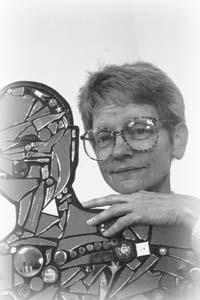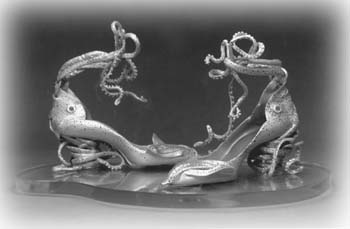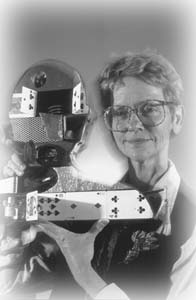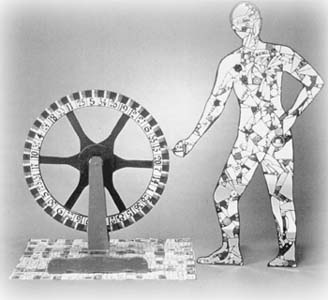![[MetroActive Arts]](/arts/gifs/art468.gif)
![[MetroActive Arts]](/arts/gifs/art468.gif)
[ Arts Index | Metro Santa Cruz | MetroActive Central | Archives ]
Footloose at Last
Photo by Robert Scheer
Stepping beyond the feminist emblems that made her artistic reputation, Gaza Bowen reconstructs her own past
By Christina Waters
Like an Oscar-winning actress forever typecast by a single, scenery-chewing role, Gaza Bowen is famous for her fancy footwear. When people think of Sigourney Weaver, they think of Ripley battling alien monsters from outer space. When people think of Gaza Bowen, they think of shoes.
Certainly we're not talking about the polite Mary Janes that were so popular with little girls during the 1950s, when Bowen grew up in Tennessee. Gaza Bowen is famous for making shrewd footgear from Woolite bottles, Brillo pads, dollar bills and rusted bottle caps. In her expert hands, such innocuous, everyday objects become politically charged manifestoes.
During the 1980s, Bowen turned out a few pithy pairs of shoes so perfectly attuned to the domestic demimonde--stiletto diaries of mad housewives--that they became feminist icons. Museums all over the world rushed to display them.
As is true for any artist, Bowen's past work is her own hardest act to follow. Nonetheless, while continuing in her own footsteps, she has subtly moved on to other issues. If Bowen's infamous shoes provided a platform for present-day politics, the new constructions involve archaeological excavations of her personal past--and, in several powerful pieces, an unsettling future.
Gaza Bowen: Walking Through Time, is a substantial retrospective of her influential body of work. It includes a first look at some new territory--territory Bowen's been exploring for the past two years since she scored one of the last remaining National Endowment for the Arts Fellowships.
At first glance, there's nothing to link the past body of work--the ironic footwear--with the new constructions sitting in Bowen's Santa Cruz Mountains studio.
"What shoes?" she quips with deadpan mischief. On the eve of her show, she's still fussing with details of metalwork veneered in vintage playing cards. Electrical circuitry needs rewiring, a few odd hinges await final instructions.
One Toe Over the Line: Santa Cruz artist Gaza Bowen's fervent and playful imagination reached the "tentacle" of its success in her world-famous "squid shoes"--"Loligopalescens"--which she created for the International Calamari Festival in the mid-1980s. During that period, she also achieved international success with her Brillo pad shoes.
The Games in the Attic
THE NEW CONSTRUCTIONS--three of which use battered luggage as a springboard for the artist's discoveries--utilize oxidized jewelry boxes, arduously distressed sheets of copper, rusted screens, optical lenses, gold leaf and garishly colored aluminum trays. The skilled shoemaker's hands are evident in each piece. Bowen is a genius with a bandsaw and thinks nothing of engineering whatever structural linchpin she can't find by rummaging through scientific catalogs, junk yards and industrial surplus warehouses.
Take the lock on Anne Frank's diary, for example.
Bowen has been busy revisiting her own childhood, growing up Jewish in the American South. Within the faded velvet covers of a replica of the famous Dutch girl's diary, Bowen has explored a favorite secret game of her girlhood.
"My best friend and I used to go up into the attic and play Anne Frank," Bowen says, her sinuous hands opening up the panels of the book, which will be displayed open, accordion-style so that each page can be read. Tracing these "memories of the '50s," Bowen has recreated the exact dimensions of Anne Frank's diary, even making a duplicate of the original lock. "As I was making her diary," she says, "making it exactly as it had been, it changed into an actual memory--into my diary."
Inside a small overnight case--the kind little girls take when they spend the night at a friend's house--Bowen has constructed an eerie cross-section of the Franks' nightmare. Two floors of a house are opened up to view, with the third floor--the attic--cordoned off by barbed wire.
"The first two floors are very middle class--my childhood--and they're contrasted with what was going on in Europe. It's about how children really absorb their world," Bowen explains. "People don't think children understand things."
But they do.
Photo by Robert Scheer
Lives Lost and Found
SELF-DISCOVERY is one of the delicious by-products of making art. With any luck, when all 37 pieces in the new Museum of Art and History show are gathered together from private collections, museums and her own studio, Gaza Bowen will be as surprised as anyone over what she finds.
"I see them as installations," she says, her perpetually amused eyes considering a mirrored image available to the viewer peeking into the Anne Frank overnight case.
"But it's true that part of the meaning of the piece comes from the case itself," she says. "I don't want this to sound weird, but often these found objects tell me what they need to continue their life."
But sometimes, the artist only discovers some meaning much later.
Bowen admits that an overnight case filled with dolls strapped in with a leather belt is a "creepy" image. "You do stuff and years later you think, 'oh, that's what that was about'," the artist says.
There is another piece, Heritage of Denial, with a menorah and Star of David tucked inside. "In the late '40s in the South, you were taught to suppress your Jewishness. The front we showed to our neighbors was Christmas lights on the lawn. Inside with our family, we were Jewish." Her brow furrows a bit.
The death of a parent inevitably provokes a personal inventory of childhood's end. When her father died two years ago, Bowen and her sister visited the family home to deal with the furniture and acquisitions of a lifetime. In two shadowbox installations, favorite family mantras are dealt with in a sudden burst of technical virtuosity.
"My mother would say that she'd stand on her ear to make us happy," Bowen admits, chuckling at both the intimacy of the expression and the implication of wife/mother as a domestic carnival act. A marionette from her own toybox recreates Bowen's mother, shown standing on her head, feet kicking in the air, balanced on a miniature barstool by her ear. "It's about how kids take things literally," Bowen says with a smile.
Uncompromising Faith
THE THEME of "making language visual," as Bowen describes the balancing-act piece, is a prevailing subtext of the recent works. "When I went through my father's house, I discovered that he had been a big collector of playing cards. That was my legacy, my fortune," she decides. "One hundred decks of playing cards." And so a lifesize metal figure of Bowen herself has been covered entirely with playing cards in a piece entitled Fortuna at Her Wheel.
In another piece, Bowen has created a three-dimensional self-portrait box in metal, again covered with cards, whose face opens into a series of "pages," each of which contains its own careworn secrets. Little boxes, lenses that splinter images into myriad questions, rusted wire overlaid with gold leaf and, finally, at the bottom layer, a mosaic of mirrors.
Each piece keeps uncompromising faith with the artist's past recaptured--yet the sheer rigor of their materials, the sculptural beauty of fabrication and, most of all, their edgy unexpectedness, keep them from sentimentality. This is a potent navigation, rather than an exclusionary trip down memory lane. The new work moves well beyond craft. Renegotiating her own childhood, Bowen holds a mirror up to ours.
Bowen admits to stockpiling what looks to the untrained eye like a lot of junk. "This is not a dump," she protests, dodging boxes and wood scraps to approach what appears to be a long bookcase.
Curious metal cases--some the size of a hand, others as large as a laptop--are lined up in a lazy row. Some are closed, offering only their eloquent exteriors for view. Others stand open, so that the inner leaves are visible, tempting our abilities to decipher the artist's personal code.
Instead of pages, burnt metal, twisted steel and embedded computer chips have been inserted between the steel book jackets. Instead of words, we find oxidized textures, the transparency of mica, the secrecy of golden wire and clouded lenses.
Deciding to see just how far she could stretch memory into pure abstraction, Bowen has created volumes written in an imaginary language. Like excerpts from some future that has already become extinct, they exist on the far side of consciousness. And the feeling they create is of an evaporating dream that you can't quite remember.
A brilliant puzzle, it raises more questions than it answers. The effect is stunning. And Bowen knows it.
She is finally ready to address the question that haunts our talk.
What does all this have to do with the shoes?
"You can look at that body of work and see indicators--things that point in directions ahead, even though I didn't know it at the time. Only in retrospect." She pauses. "I really think the shoes are containers. There's an inside and an outside--and that's what I'm looking at with these new pieces."
Gaza Bowen playfully admits that her nemesis "was having made such a splash with the shoes--it was so timely, so of that moment. But now, well, you always want your new stuff to be the most exciting."
It is.
This page was designed and created by the Boulevards team.

Head of the Glass: "Gaza Bowen: Walking Through Time," an exhibit of the Santa Cruz artist's past decade of work, is on display May 10June 29 at the Museum of Art & History, 705 Front St., SC. The show can be viewed noon-5pm TuesdaySunday (until 7pm on Friday). Tickets cost $3 general and $2 for county residents. For more info, call 429-1964.
Paul Schraub
Trickster of the Trade: Trained shoemaker Gaza Bowen wandered from the tried-and-true path of design into the fast lane of conceptual art with her agit-prop footwear, a direction she continues to tread with her latest artistic constructions.
House of Cards: Gaza Bowen was inspired to create her recent "Fortuna at Her Wheel" when she discovered her father's collection of 100 decks of playing card after his death.
From the May 8-14, 1997 issue of Metro Santa Cruz
Copyright © 1997 Metro Publishing, Inc.